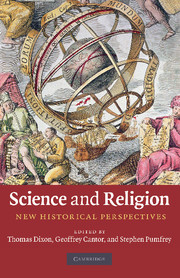Book contents
- Frontmatter
- Contents
- List of contributors
- Preface
- 1 Introduction
- PART I CATEGORIES
- PART II NARRATIVES
- PART III EVOLUTION AND CREATIONISM
- PART IV THE POLITICS OF PUBLISHING
- 9 A global history of science and religion
- 10 The Scopes trial beyond science and religion
- 11 Science, religion, and the history of the book
- PART V WAYS FORWARD
- Select bibliography
- Index
11 - Science, religion, and the history of the book
Published online by Cambridge University Press: 05 May 2010
- Frontmatter
- Contents
- List of contributors
- Preface
- 1 Introduction
- PART I CATEGORIES
- PART II NARRATIVES
- PART III EVOLUTION AND CREATIONISM
- PART IV THE POLITICS OF PUBLISHING
- 9 A global history of science and religion
- 10 The Scopes trial beyond science and religion
- 11 Science, religion, and the history of the book
- PART V WAYS FORWARD
- Select bibliography
- Index
Summary
John Hedley Brooke's Science and religion: Some historical perspectives (1991) has had a profound impact on a generation of students of the subject, but my engagement with the book was particularly personal, since at the time it was published I was nearing the end of my doctoral researches under the inspiring tutelage of its author. His emphasis on the ‘diversity of interaction’ became a central component of my study of the Bridgewater treatises, a bestselling series of eight works on the ‘Power, Wisdom, and Goodness of God as manifested in the Creation’ penned in the 1830s by leading men of science. Whereas Robert M. Young had argued that the series gave paradigmatic expression to a ‘relatively homogeneous and satisfactory natural theology’ in the period, my study extended Brooke's earlier work on the diversity of natural theology in the early nineteenth century by claiming that the Bridgewater treatises developed a range of approaches expressive of the differing theologies and interests of their authors. In addition, my approach drew on Brooke's analysis of the divergent functions that natural theologies fulfilled, ranging from their capacity to evoke awe in religious believers to their role in mediating between different theological positions. However, in pursuing these themes further I also found myself exploring new historiographical avenues. In particular, the notion that the diverse natural theologies of the Bridgewater treatises might serve a range of functions for their original readers led me to ask questions about those original readers that gradually led me towards the then still-nascent interdisciplinary field of book history, and much of my subsequent research has been situated in the intersection between these fields.
- Type
- Chapter
- Information
- Science and ReligionNew Historical Perspectives, pp. 221 - 244Publisher: Cambridge University PressPrint publication year: 2010
- 5
- Cited by



